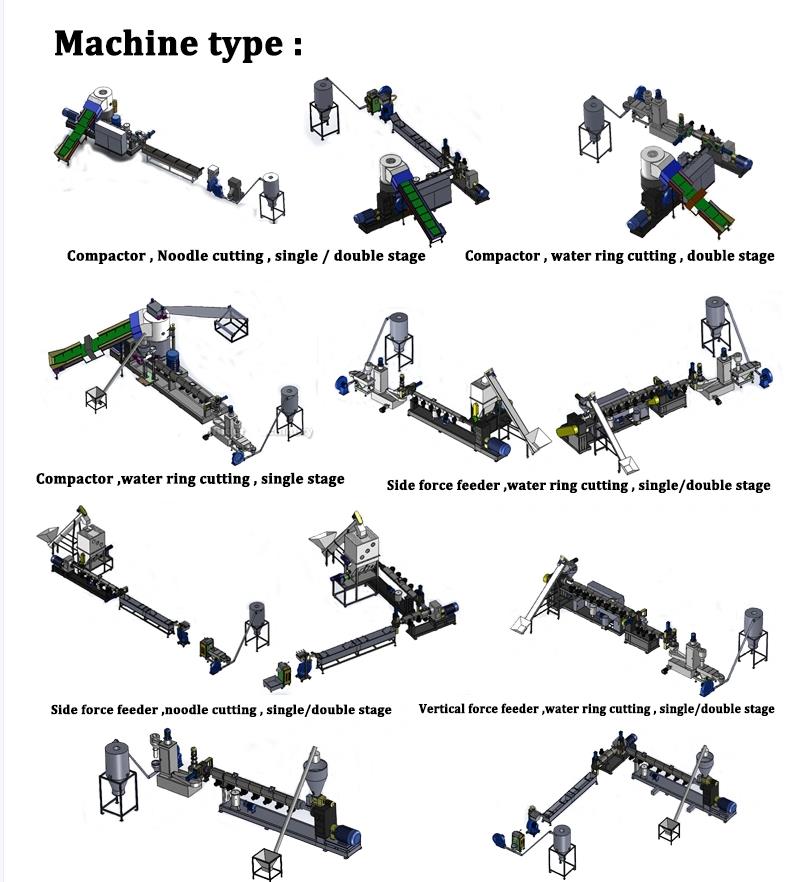News
Difference Between Plastic Recycling Washing Equipment and Plastic Pelletizing Equipment
In the plastic recycling industry, two core pieces of equipment—plastic recycling washing equipment and plastic pelletizing equipment—play distinct yet complementary roles in turning waste plastic into reusable resources.
While both serve the overarching goal of plastic circularity, their core functions, working processes, application scenarios, and technical focuses differ significantly. Below is a detailed breakdown to clarify their unique values in the recycling chain, helping partners and stakeholders better understand how they work together to drive sustainable recycling.
Plastic recycling washing lines are mainly used to clean and separate plastic waste such as films, bottles, and hard plastics. The washing process removes contaminants like dust, labels, oil, and glue to ensure the plastic flakes are clean and pure.
Typical washing lines include stages such as shredding, washing, friction cleaning, floating separation, and drying.
Clean and dry flakes produced by this equipment are the raw materials for the next step — pelletizing.
Plastic pelletizing machines are designed to melt, filter, and extrude the cleaned plastic flakes into uniform plastic pellets (granules). These pellets can then be used for manufacturing new plastic products.
Depending on the material type and production needs, pelletizing systems can be single-stage, double-stage, or parallel twin-screw, and often include stranding , water-ring, or underwater pelletizing systems.
2. Working Process:
Their workflows are designed to match their core functions, with clear sequential logic (washing always comes before pelletizing):
Crushing: Large plastic waste (e.g., whole PET bottles) is shredded into small flakes (5-15mm) to increase the contact area for cleaning.
Pre-washing: High-pressure water rinses off surface dust, loose labels, and soluble contaminants (e.g., beverage residues in bottles).
Main washing: Using heated water, eco-friendly detergents, or mechanical friction (e.g., scrubbing rollers), stubborn stains (e.g., oil on industrial plastic scraps) and adhesive residues are removed.
Rinsing & Dewatering: Clean water washes away detergent residues, followed by spin-drying or air-drying to reduce the moisture content of plastic flakes (usually to ≤5%), preventing issues like bubbling during pelletizing.
Feeding & Melting: Clean plastic flakes are fed into an extruder, where they are heated (temperature varies by plastic type: ~160-280°C) and melted into a homogeneous molten plastic fluid.
Filtration: The molten plastic passes through a high-precision screen (usually 60-120 mesh) to remove tiny remaining impurities (e.g., small paper fibers), ensuring pellet purity.
Extrusion & Cooling: The filtered molten plastic is extruded through a die head into thin plastic strips, which are immediately cooled in a water bath or by air to solidify.
Cutting: A rotating cutter trims the solidified strips into uniform pellets (typically 2-5mm in length/diameter), which are then dried and packaged for sale or reuse.

Their use cases are defined by their position in the recycling line:
Plastic Recycling Washing Equipment: It is a mandatory preprocessing tool for all plastic recycling plants. Whether handling post-consumer waste (e.g., household plastic bottles) or post-industrial scrap (e.g., plastic injection molding offcuts), washing equipment ensures the raw material meets the minimum purity requirement for pelletizing. It is especially critical for food-grade plastic recycling (e.g., recycled PET for beverage bottles), where strict impurity control is required.
Single-screw pelletizers: Suitable for processing low-contamination, single-type plastics (e.g., pure PE film flakes) and are cost-effective for small-to-medium production scales.
Twin-screw pelletizers: Ideal for mixed plastics or high-contamination materials (e.g., plastic scrap with small impurities), offering better melting uniformity and higher production capacity—widely used in industrial-grade plastic recycling (e.g., manufacturing plastic pipes, auto parts).
4. Technical Focus: Impurity Removal vs. Pellet Consistency
The technical design of each equipment prioritizes different performance indicators:
Plastic Recycling Washing Equipment:
Key metrics include impurity removal rate (≥98% for high-end models), water consumption (advanced closed-loop systems reduce water use by 60-80%), and dewatering efficiency (to avoid affecting pelletizing quality). Energy-saving heating systems and eco-friendly detergent compatibility are also critical for reducing environmental impact.
Plastic Pelletizing Equipment:
Technical highlights focus on pellet quality and production stability:
Pellet size consistency (tolerance ≤0.1mm) to ensure uniform feeding in downstream manufacturing.Melting uniformity (to prevent material degradation from overheating, which weakens the mechanical properties of pellets).
Filtration precision (to remove micro-impurities that cause defects in final products, such as bubbles or cracks).
5.Conclusion: Two Indispensable Links for Plastic Circularity
Plastic recycling washing equipment and plastic pelletizing equipment are not competitors—they are sequential, complementary pillars of a complete recycling line. The washing equipment ensures "clean raw materials," while the pelletizing equipment turns those materials into "valuable products."
By understanding their differences, recycling enterprises can optimize line configuration, improve production efficiency, and produce high-quality recycled pellets that meet market demands—ultimately advancing the shift toward a more sustainable, circular plastic economy.
For customized solutions of plastic recycling washing or pelletizing equipment, or to learn how to integrate them into your recycling line, please contact our technical team today.
www.allwinrecycling.com whatsapp:+8613952443782
No previous




